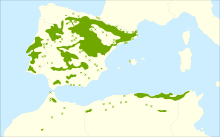| Portuguese oak | |
|---|---|

| |
| Conservation status | |
 Least Concern (IUCN 3.1) | |
| Scientific classification | |
| Kingdom: | Plantae |
| Clade: | Tracheophytes |
| Clade: | Angiosperms |
| Clade: | Eudicots |
| Clade: | Rosids |
| Order: | Fagales |
| Family: | Fagaceae |
| Genus: | Quercus |
| Subgenus: | Quercus subg. Quercus |
| Section: | Quercus sect. Quercus |
| Species: | Q. faginea |
| Binomial name | |
| Quercus faginea Lam. | |

| |
| Distribution map | |
| Synonyms | |
| |
Quercus faginea, the Portuguese oak, is a species of oak native to the western Mediterranean region in the Iberian Peninsula. Similar trees in the Atlas Mountains of northwest Africa are usually included in this species, or sometimes treated as a distinct species, Quercus tlemcenensis. It occurs in mountains from sea level to 1,900 metres (6,200 feet) above sea level, and flourishes in a variety of soils and climates. Out of all the oak forests in the Iberian Peninsula, the southern populations of Portuguese oak were found to have the highest diversity and endemism of spider species.
Description
Q. faginea is a medium-sized deciduous or semi-evergreen tree growing to 20 metres (66 feet) tall, with a trunk up to 80 centimetres (31 inches) in diameter, with grey-brown bark. The tree can live as long as 600 years. The leaves are 4–10 cm (1+1⁄2–4 in) long and 1.2–4 cm broad (rarely to 15 cm long and 5 cm broad), glossy dark green to gray-green above, and variably felted grey-white below; the margins have five to 12 pairs of irregular teeth. Leaf fall is typically in mid- to late winter. The flowers are catkins, produced between March and April, almost always before holm oak, which grows in similar areas. The acorns are oblong-ovoid, 2–2.5 cm long, maturing in 6 months to disperse in September or October.
The species commonly develops galls due to gall wasp activity; the galls are brown, 1–2 cm diameter, and have a spongy, cork-like interior.
The two subspecies are:
| Image | Scientific name | Description | Distribution |
|---|---|---|---|
 |
subsp. faginea | Rarely exceeds 15 meters in height, smaller, greener, dentate-serrate leaves, shorter catkins (2–4 cm), distributed through more continental climates around 500-1500m altitude. Predominant subspecies in Spain. | Native to the Iberian Peninsula |
 |
subsp. broteroi (Cout.) A.Camus (syn. Q. tlemcenensis) | Can reach up to 20m in height, larger, densely tomentous, ashen, crenate-dentate leaves and longer catkins (4-7.5cm), distributed alongside rivers and streams, slopes and valleys up to 700m altitude. Predominant subspecies in Portugal. | Native mainly to Northwest Africa and the Southwest of the Iberian Peninsula |
Portuguese oak also hybridises readily with other related oaks such as Algerian oak (Q. canariensis) and downy oak (Q. pubescens), which can make identification difficult.
The specific name faginea refers to the superficial resemblance of the leaves to those of the beech (Fagus).
Uses
The wood has been used traditionally as firewood and as timber for construction (beams and posts). The acorns, like those of the holm oak or cork oak, are an important food for free-range black Iberian pigs reared for jamón ibérico production. It is also occasionally planted as an ornamental tree.
Gallery
References
- Jerome, D.; Vazquez, F. (2018). "Quercus faginea". IUCN Red List of Threatened Species. 2018: e.T78916251A78916554. doi:10.2305/IUCN.UK.2018-2.RLTS.T78916251A78916554.en. Retrieved 19 November 2021.
- "Quercus faginea Lam.". World Checklist of Selected Plant Families. Royal Botanic Gardens, Kew – via The Plant List. Note that this website has been superseded by World Flora Online
- Malumbres-Olarte, Jagoba; Crespo, Luís Carlos; Domènech, Marc; Cardoso, Pedro; Moya-Laraño, Jordi; Ribera, Carles; Arnedo, Miquel A. (2020-12-01). "How Iberian are we? Mediterranean climate determines structure and endemicity of spider communities in Iberian oak forests". Biodiversity and Conservation. 29 (14): 3973–3996. doi:10.1007/s10531-020-02058-7. hdl:10138/337709. ISSN 1572-9710. S2CID 225151221. Retrieved 11 June 2021.
- Sequeira, Inês (2020-11-16). "Cientistas descobrem que é nos bosques de carvalho-português que há mais espécies de aranhas". Wilder (in European Portuguese). Retrieved 11 June 2021.
- "Quercus faginea". Flora Europaea. Edinburgh: Royal Botanical Garden. 2008.
- Bean, W. J. (1976). Trees and shrubs hardy in the British Isles 8th ed., revised. John Murray.
- Rushforth, K. (1999). Trees of Britain and Europe. HarperCollins ISBN 0-00-220013-9.
- CAB International (2005). data on Quercus faginea, Forestry Compendium Archived October 9, 2007, at the Wayback Machine. Retrieved 27 July 2006.
- ^ "Quercus faginea" (PDF). Flora Iberica. Retrieved September 12, 2020.
External links
- Jean Louis Helardot, Chênes: Quercus faginea (in French)

